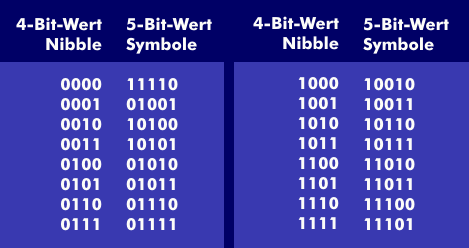4 binary, 5 binary (4B5B)
The quaternary 4B5B coding is used in high-speed networks. In this line coding, all data is divided into 4-bit units, a nibble or quadbit, and recoded into 5-bit units (symbols) according to a table. Hence the name "4 bit nibble to 5 bit symbol".
This coding table is structured in such a way that, regardless of the input data, symbols with more than three zeros in sequence never occur. The advantage of this coding is that one can use Non Return to Zero Inverted( NRZ-I) without losing synchronization in long zero sequences. A disadvantage is the 25% overhead that results from the conversion from 4-bit to 5-bit units. This means that with FDDI, where this coding is used, the data rate on the transmission medium must be increased to 125 Mbit/s so that 100 Mbit/s are available as the user data rate. Of the 32 different characters generated with the 4B5B code, 16 are required for user data transmissionand the remaining 16 for control purposes.
The Manchester coding known from Ethernet cannot be used in high-speed LANs (HSLAN) for economic reasons, since it changes state twice for each transmitted bit and thus occupies twice the bandwidth.

